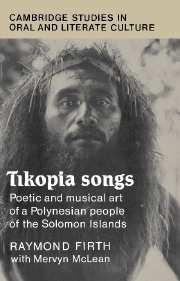Book contents
- Frontmatter
- Contents
- ILLUSTRATIONS
- FIGURES
- Preface
- Acknowledgements
- Sketch map of Tikopia (approx. 5 sq. km.)
- Part I General
- Part II Musical analysis (by Mervyn McLean)
- Part III Song texts, translations and commentary
- 6 Dance songs of everyday life
- 7 Songs of the sea and of travel
- 8 Eulogies and farewells
- 9 Songs of protest and criticism
- 10 Songs of erotic arousal and sex antagonism
- 11 Laments and funeral dirges
- 12 Songs on historical and mythic themes, and of ritual quality
- 13 Epilogue
- Appendix 1 Composers to whom songs attributed
- References
- Index
13 - Epilogue
Published online by Cambridge University Press: 07 May 2010
- Frontmatter
- Contents
- ILLUSTRATIONS
- FIGURES
- Preface
- Acknowledgements
- Sketch map of Tikopia (approx. 5 sq. km.)
- Part I General
- Part II Musical analysis (by Mervyn McLean)
- Part III Song texts, translations and commentary
- 6 Dance songs of everyday life
- 7 Songs of the sea and of travel
- 8 Eulogies and farewells
- 9 Songs of protest and criticism
- 10 Songs of erotic arousal and sex antagonism
- 11 Laments and funeral dirges
- 12 Songs on historical and mythic themes, and of ritual quality
- 13 Epilogue
- Appendix 1 Composers to whom songs attributed
- References
- Index
Summary
This brief chapter is intended to examine some main features of Tikopia songs, as exemplified in the previous chapters, and to focus on some aspects of more general significance to the study of oral poetic material, inherent in this book as a whole. To grasp the significance of Tikopia songs it is essential to realise the unique situation of the island community – remote, isolated in the far southeast of the Solomon Islands. For many generations the people had only slender contact with the world outside, so their traditional music was completely internally generated, created by the people themselves to meet their own needs, and fitted closely to their way of life.
The first point to emphasise is the prime importance of songs and singing in Tikopia life. The Tikopia have not had any highly developed graphic or plastic art – no free-standing wooden sculptured human figures, for example, as made by Maori or Hawaiians. Their energies have gone into the field of the performing arts, to some extent into dance, but especially into the composition of songs. In traditional Tikopia society and even to a considerable degree in their modern communities, songs have been an integral feature of their social life. Solo singing has occurred, but for the most part it is by choral singing that the Tikopia have demonstrated their need to express themselves on occasions of social significance to them. Reception and farewell of visitors, dancing, initiation of boys, sickness, death, removal of mourning have all been marked by songs of an appropriate kind, allowing recognition of social norms and an outlet for personal emotion.
- Type
- Chapter
- Information
- Tikopia SongsPoetic and Musical Art of a Polynesian People of the Solomon Islands, pp. 293 - 297Publisher: Cambridge University PressPrint publication year: 1991



